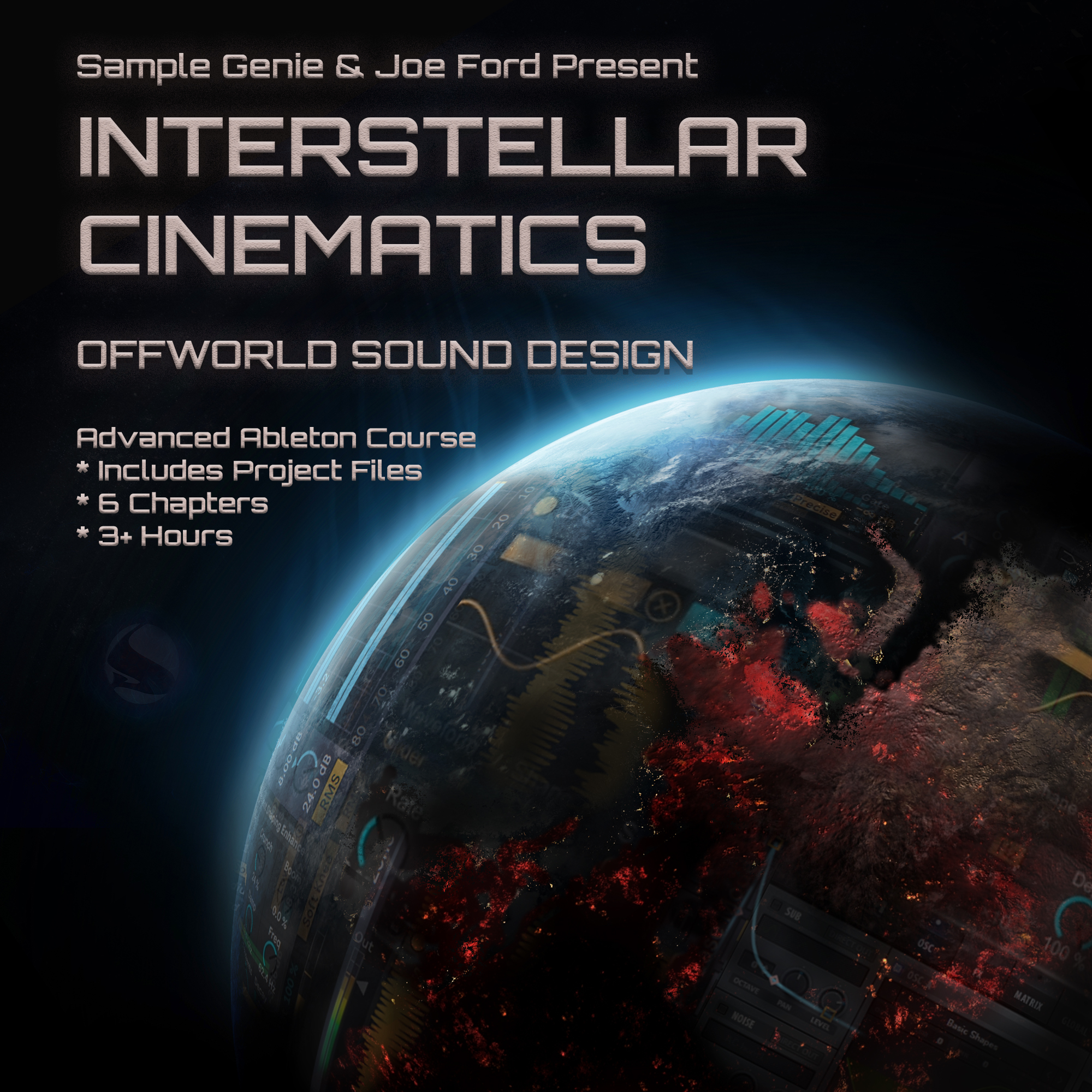Analysis of 65E03: QZB – Minimalism
- This topic has 2 replies, 2 voices, and was last updated 5 years, 10 months ago by ,
 Mind Zero.
Mind Zero.
-
AuthorPosts
-
-
2018-09-07 at 21:02:28 #51682,
 HarryModerator
HarryModeratorThere is already a great conversation about this trio of videos going on, found here:
QZB themselves have been interacting with members and answering follow up questions, I almost wanted to hold off on writing up my notes. I personal found the videos very interesting, coming away with some further ideas, and a few things that I will need to rewatch and work out. With that said, here is my timeline analysis of QZB’s first tutorial for Sample Genie.
Video #1: Drums (46:41)
01:30 – starting with drums, usually QZB does not start here though02:00 – Ableton’s Operator with a chain/container/macro for creating for creating kick drums
– Set pitch for kick, tuned to E1 (41.2 Hz)
– Usually pitch drums to the other music parts
– Program a typical 2-step pattern (*NOTE: November 2018 Lamp Session will be a “no 2-step” challenge)04:15 – make adjustments to the kick
05:35 – layering in a sampled kick, for the higher frequency characteristics
– Sample kick is for the sound, synth kick is for the feel
– Actual fades in the sample to take away its transient, as the synth kick has the transient QZB wants
– Low cut the sample
– QZB also takes away some of the tail of the sample08:30 – adjust volumes on the mixer so the kick peaks at -6 dB
– QZB reiterates that -6 dB is just a reference point09:30 – explains adding another layer, and then subtle saturation of all the layers
10:50 – emphasizing restrained use of compression
11:40 – EQ to boost E2 note (82.4 Hz)
12:20 – snare follows a similar process, but a snare chain/container/macro is used
– QZB aims for the fundamental to be a fifth of E2, so the snare is at A3 (220 Hz)15:00 – Adjusting decay to get a shorter hit
17:30 – EQ to take out low end
18:00 – theory on using stock plugins for smaller work on sounds, less taxing on the computer
20:00 – reverb as an insert effect on the snare track, using a small reverb that won’t be used anywhere else in the track
– Tweaks decay time with reverb at 100% wet, then adjusts to lower dry/wet setting once they find the sound that they want.22:40 – hats, which are not fixed pitch but note dependent
– Adjusts levels
– A little saturation
– Sidechain compression, can be used creatively or for mixdown reasons. These hats are being triggered by the kick group.27:00 – explains how compressor would effect the tail of the kick, relates to why they faded off the tails
– Subtle sidechain application
– Creative = pumping
– Mixdown reasons = making space for energy of sounds
– Also sidechained to snare, but different settings30:00 – how QZB applies breaks
– Reminds watchers to be mindful of the preview volume, try to have it match the volume of the track’s other drums
– Copies kick & snare sidechaining plugins, adjusts levels
– Sidechaining the break’s snare hits can sound more organic than just EQ cutting34:30 – discussing Ableton’s warp algorithms
– Focus is on the preserve transient function36:15 – adds another break and discusses using just its shuffles
– Sets up a shuffle group and copies over sidechain compressors38:00 – describes this video as more of a jam session, usually there is more bouncing of layers
39:15 – setting up a drum bus
40:00 – resampling the different drum parts, recording passes of tracks rather than just using a bounce function
– Records parts with out sidechaining applied, will apply later.
– Bounces the layer break and shuffles together.42:00 – QZB expresses a similar philosophy as Hybris regarding resampling as committing to a sound, and resetting your brain a little bit.
43:00 – utilizing the consolidate function
45:00 – QZB often tries transposing drums to fifths of the fundamental frequency of the track
—
Video 2: Bass (30:36)
– QZB start by stating one can be productive at any time, even when not feeling creative.01:10 – a one note sub bass, with a minimum of two layers
– Hip-Hop Sub chain/container/macro, but using just a sine
– Recorded in E to create the first layer, a sine sub
– Recommend starting with a sine04:50 – variations, such as pitch dropping
05:40 – starting with layering
– Ableton’s Erosion for high frequencies.09:00 – describing other layering options
11:00 – when layering, you are trying to trick the listeners’ ear to think the layers are all one instrument
– Relates to the issue of using pitch dropping on one layer, you need to set up all the other layers to pitch drop as well, in time, else the sound loses its cohesiveness.12:00 – using EQ on harsh sounds to isolate small bands that can then be used and processed creatively.
– “A work of patience.”16:00 – technique for variations of the bass
– Erosion layer is muted
– Auto-filter creating movement, and thus creating interesting rhythms.
– Recording the movements to a new audio file.22:00 – saturation in a layer splitter
– Chopping out parts they like.—
Video 3: Sequence (25:22)
– QZB describe their styles as surgical, and comprised of a lot of trial & error, and a lot based on feel.
– Mixing and matchings mids until they get something that sounds “right”.03:00 – looking at limiting options.
15:00 – discussion of “finding ‘the one’ sound” to base a track around.
—–
THOUGHTS & NOTES:
– The fact that QZB stuck to the stock plug-ins very inspiring, and a great demonstration of knowledge of their tools.
– I was surprised about how the synth drums had a sub frequency fundamental, rather than using the next octave up, and need to rewatch. I recall them boosting EQ at what I would think should have been the fundamental though.
– Really in to the workflow to get variations of the mid bass, and building up self made samples.
– I wasn’t clear on why they preferred recording passes of tracks for resampling vs. bouncing down clips, but this might be my unfamiliarity with Ableton. I know in Bitwig I can do a similar record pass, but I can also do a bounce of a track (which will record all the effects on the track), as well as bounce-in-place (records the clip but without effects applied).
– Kind of missed what they found to be the benefit(s) of the Consolidate function; I guess that they could keep clips from the track together?
– Thinking in terms of transposing by fifths, 7ths and 9ths.
– I need to rewatch the last ten minutes of the bass section, and maybe rewatch video 3 to see if there was anything major I should have noted, like how they would shift the placement of the mid bass on the arrangement."Knowledge kept is knowledge lost." - Bobbito Garcia
-
2018-09-07 at 22:05:00 #51689,
 Mind ZeroParticipant
Mind ZeroParticipantI use Ableton to produce so I think I can answer to the consolidate thing: it’s a fast way of saving the shape you’ve created for that audio, like timestretching or transposing, so you create a new audio clip with that modifications done, instead of recording or bouncing the track. For me it’s kind of a visual thing, as you can see the new waveform of the new audio clip and you keep using the same channel with the same chain.
-
2018-09-07 at 22:07:10 #51690,
 Mind ZeroParticipant
Mind ZeroParticipantAlso useful when you’re using slices of a big audio file, like the bass recordings they did, as you create a small audio clip with just the part that you have consolidated, that should save some work for the hard disk.
-
-
AuthorPosts
- You must be logged in to reply to this topic.


